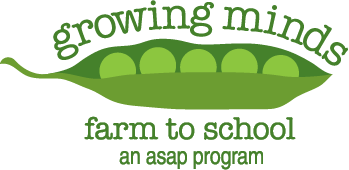| Classroom Activity |
Accompanying Books |
Description |
Suggested Month |
| Colorful Plate Spinners |
Rah Rah Radishes! |
Students learn to identify new fruits and vegetables. Students associate vegetables and fruits with a positive experience making a fun art project. |
August |
| Taste and Tales |
various books will work well with this lesson |
Children learn about vegetables and fruits through children’s literature and taste tests. |
August |
| Tomato Exploration |
Little Yellow Pear Tomatoes |
Children gain familiarity with different types of tomatoes and explore how they taste. Children become comfortable with tasting new foods in the supportive, positive environment of their preschool. Children learn that many vegetables come in lots of different varieties that all look and taste different. |
August |
| Tomato Salsa |
Chicks and Salsa |
Students will learn how to make fresh salsa with local ingredients. |
August |
Melon Exploration
|
One Watermelon Seed |
Children learn about different types of melons (cantaloupe, watermelon, and honeydew) grown in WNC, become familiar with tasting new foods, and practice using their senses to explore environments. |
September |
| Cucumber Stacks |
I Will Never Not Ever Eat a Tomato |
Children learn how to make their own snack and through a hands on cooking experience gain motivation to try a new vegetable. Children learn about kitchen utensils and how to use them to make a specific recipe. |
September |
| Cabbage Exploration |
The Giant Cabbage |
Children gain confidence in trying new foods and become familiar with a new vegetable. Through a hands-on activity, children explore a new vegetable and taste two varieties of cabbage. |
October |
| Pumpkin Exploration |
How Many Seeds in a Pumpkin |
Through a creative exploration of pumpkins, students gain a new understanding of this vegetable and all of its diverse uses. Students use a pumpkin seed activity to practice counting. |
October |
| Roots and Shoots |
Up, Down, and Around |
Teach students about how vegetables grow and guide them in tasting veggies that grow below ground and above ground. |
November |
| Sweet Potato Exploration |
Potato Joe |
Children use their sense to explore sweet potatoes and gain confidence in trying new vegetables. Students learn to identify a new vegetable. Students associate vegetables and fruits with a dynamic activity and positive experience. |
November |
| Apple Exploration |
Apple Farmer Annie |
Children use their sense to explore apples and gain confidence in trying new fruits. |
December |
| Insects in the Garden |
Insects are my Life |
Introduce students to insects and other bugs they will find in the garden, their characteristics, and how they affect plants. Teach students to observe (rather than harm) living things in the garden and natural environment. |
January |
| Cooking Play |
Sip, Slurp, Soup, Caldo, Caldo, Caldo |
Children learn about a variety of cooking tools including plastic knives, measuring spoons and cups, whisks and mixing spoons. Through a fun, dynamic learning environment children explore how to use the tools successfully. |
February |
| Fruit and Veggie Alphabet Border |
Eating the Alphabet |
Children gain knowledge and interest in new fruits and vegetables through making an alphabet border for the classroom. Students learn to identify new fruits and vegetables. Students work together to complete a class project. |
February |
| Seed Exploration |
Seeds! Seeds! Seeds! |
Children learn about seeds through hands-on activities, inquiry, and seed exploration. |
March |
| What Plants Need |
The Seed Song |
Children will become familiar with the different things plants need to survive and grow. Children will learn to listen and participate in a group activity while outdoors in the garden through this movement based activity. |
March |
| Watering the Garden |
Water, Weed, and Wait |
Children learn that plants need water just like people and animals need water. They will explore dry and wet soil and be able to describe the difference between them. Children will practice testing soil for dampness using their fingers. Children will be introduced to a rain gauge and its purpose. |
April |
| Weeding the Garden |
The Curious Garden |
Children will recall information about plants and add to their understanding of what plants need to grow. In the garden, children will use pictures (or sample plants) and follow instructions to identify weeds and pull them. Children will work in teams to sort, count, and classify their weeds. |
April |
| Garden Color Hunt |
Planting a Rainbow |
Students explore the garden and will practice garden rules. They will learn to observe and look closely in the garden by beginning to recognize and appreciate different colors. |
May |
| Veggie Crowns |
Oliver’s Vegetables |
Children gain knowledge and interest in new fruits and vegetables through making vegetable crowns. Students learn to identify new fruits and vegetables. Students associate vegetables and fruits with a positive experience making a fun art project. |
June |
| Veggie Castles |
Scarlette Beane |
Children become comfortable with tasting new foods in the supportive, positive environment of their preschool. Children learn about and learn to identify different types of local fruits and vegetables. |
June |
| Berry Parfaits |
Blueberries for Sal |
Children learn about different types of fresh berries and practice their listening skills to follow instructions and make their own individual snack. |
July |
| Garden Plot Crackers |
Bear and Bunny Grow Tomatoes |
Children learn how to make their own snack and through a hands-on cooking experience gain motivation to try new local vegetables. |
July |
